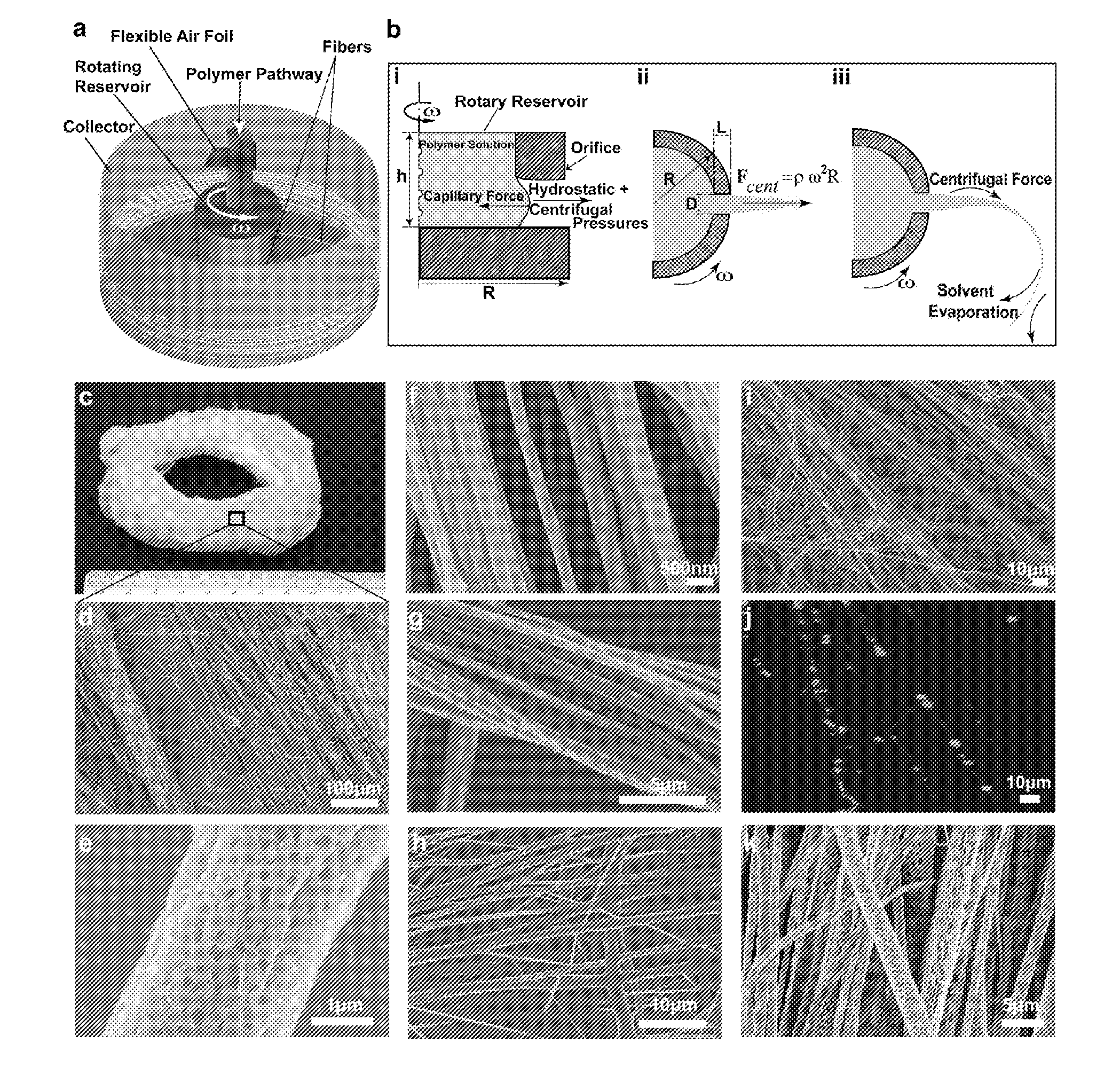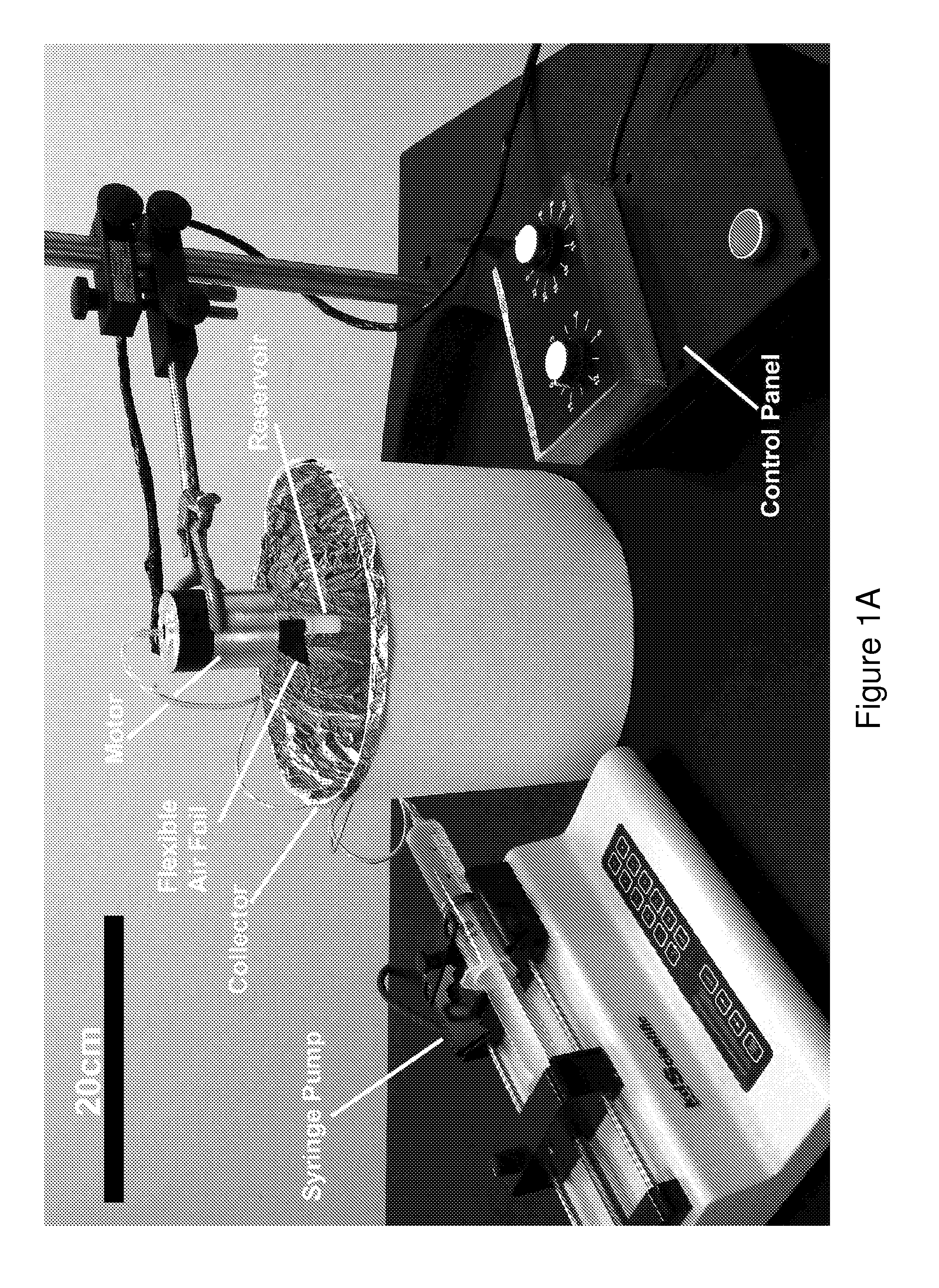Methods and devices for the fabrication of 3D polymeric fibers
a polymeric fiber and 3d technology, applied in the direction of cell culture supports/coatings, dough sheets/rolling machines/rolling pins, peptide/protein ingredients, etc., can solve the problems of low production rate and high voltage electrical field, and achieve the effect of treating or preventing tissue diseases
- Summary
- Abstract
- Description
- Claims
- Application Information
AI Technical Summary
Benefits of technology
Problems solved by technology
Method used
Image
Examples
example 1
Rotary Spinning System: A Novel 3D Nanofiber Assembly Fabrication
[0168]In order to produce polymeric fibers, e.g., nano-scale fibers, a high speed rotating nozzle was exploited to form a polymer jet which undergoes extensive stretching before solidification (FIG. 2a). Termed rotary jet-spinning (RJS), the RJS system consisted of a reservoir with two side wall orifices that was attached to the shaft of a motor with controllable rotation speed. To facilitate the fiber collection a flexible air foil is placed on the shaft above the reservoir. The polymer solution was continuously fed to the reservoir at a rate sufficient to maintain a constant hydrostatic pressure and continuous flow. The resulting fibers were collected either on a stationary, surrounding cylindrical collector or on coverslips which were held against the collector wall. The fiber production process is composed of (i) jet-initiation to induce flow of the polymer solution through the orifice, (ii) jet-extension to increa...
example 2
Fabrication of Polymeric Fibers Using A Rotary Spinning System
[0169]Using a rotary spinning system described herein, 3-dimensional micron, submicron and nano-scale structures from a variety of synthetic and naturally occurring polymers. Polymeric fibers were produced from poly (lactic acid) (PLA) in chloroform (FIGS. 2c-2e), poly (ethylene oxide) in water (FIG. 2f), poly (acrylic acid) in water at different conductivities (neutralized with sodium hydroxide) (FIGS. 2g and 2h), gelatin in mild acetic acid (FIG. 2i), an emulsion of gelatin in PLA (FIG. 2j) and PEO doped with fluorescent spherical beads (FIG. 2k).
[0170]The successful production of polymeric fibers using a variety of synthetic and naturally occurring polymers, demonstrates that the devices methods described herein provide a rapid and facile technique of polymeric fiber, e.g., nanofiber fabrication without electrical propulsion which is capable of fabricating 3D aligned polymeric fibers, e.g., nanofiber, structures from a...
example 3
Fabrication of Polymeric Fibers Using A Rotary Spinning System
[0171]Using a rotary spinning system described herein, 3-dimensional micron, submicron and nano-scale structures of biodegradable polylactic acid (PLA) polymer and hydrophilic polyethylene oxide (PEO) polymer were fabricated.
[0172]PLA was dissolved in either chloroform or dichloromethane and PEO was dissolved in either water, or a water / ethanol mixture. Various concentrations of solutions of the aforementioned polymers were prepared by mixing different weights of dry polymer in the corresponding solvents and then fed through a material feeding tube made of polyethylene into a rotating reservoir including two sidewall orifices. The resulting fibers were collected on the stationary collector. The spatial and hierarchical structure of the produced fibers was changed by altering rotation speed, polymer solution concentration, viscosity of polymer solution, polymer molecular weight, volatility of solvent, geometry of collector...
PUM
| Property | Measurement | Unit |
|---|---|---|
| diameter | aaaaa | aaaaa |
| temperature | aaaaa | aaaaa |
| temperature | aaaaa | aaaaa |
Abstract
Description
Claims
Application Information
 Login to View More
Login to View More - R&D
- Intellectual Property
- Life Sciences
- Materials
- Tech Scout
- Unparalleled Data Quality
- Higher Quality Content
- 60% Fewer Hallucinations
Browse by: Latest US Patents, China's latest patents, Technical Efficacy Thesaurus, Application Domain, Technology Topic, Popular Technical Reports.
© 2025 PatSnap. All rights reserved.Legal|Privacy policy|Modern Slavery Act Transparency Statement|Sitemap|About US| Contact US: help@patsnap.com



